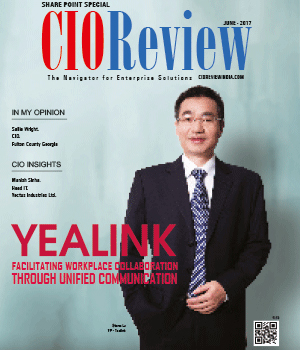
Why SharePoint is a Robust and Powerful Digital Platform?
Sandy Jacolow, CIO, Silverstein Properties | Friday, 23 June 2017, 05:20 IST
 As CIOs, one of our primary objectives is to transform the way our employees visualize information. Through our collaboration with business owners, we are facilitators of embraceable change, and we strive to enhance process efficiencies, access to information and ultimately profitability. We need arrows in our quivers that aim to empower people with knowledge, strategies that focus on intelligence-centric solutions capable of surpassing today’s personal computing experience.
As CIOs, one of our primary objectives is to transform the way our employees visualize information. Through our collaboration with business owners, we are facilitators of embraceable change, and we strive to enhance process efficiencies, access to information and ultimately profitability. We need arrows in our quivers that aim to empower people with knowledge, strategies that focus on intelligence-centric solutions capable of surpassing today’s personal computing experience.
Microsoft's SharePoint Technologiesis more than an essential tool to achieve these goals. It is designed to deliver value-added business solutions to a wide range of companies. Often envisioned as a corporate Intranet or Enterprise Content Management system, SharePoint is a robust and powerful digital platform. Its extensibility allows both “power users” and programmers alike to develop adaptable information retrieval and analytical solutions. SharePoint’s flexible architecture has the ability to harness the convergence of today’s advance technologies such as Big Data, Mobility, Cloud Computing, and Social Networking, changing the way we engage with our clients and communities.
"SharePoint truly shines in its ability to deliver a broad range of information in assorted styles adaptable to meet today’s frenetic rate of change"
In a society that thrives on continual partial attention, where decisions are made in the moment, turning bits and bytes of data into actionable information can lead to proactive rather than reactive decisions. Enterprises have vast amounts of information in different repositories, requiring a laborious data-mining exercise to understand key performance metrics. In real estate, these indicators range from monitoring operating expense and leasing targets, which in tandem drive cash flow. These incongruous database structures make it inherently difficult to build content rich systems necessary to gain deeper insight into patterns and trends. SharePoint's ability to combine multiple data sets makesit an optimal mechanism for delivering a more holistic view of one’s business essentially filtering out the noise.
Delivering Business Intelligence with SharePoint:
To provide Senior Management with key metrics for our portfolio, we started by building a Microsoft SQL Server Analysis Services (SSAS) cube to house data points from multiple distinctand bespoke systems. Predicated on business and reporting requirements, we scripted a series of ETLs (Extract, Transform and Load) designed to aggregate and normalize data at varying frequencies and intervals. Leveraging SSAS allowed us to transition flat silos of information to a homogenous Big Data platform structured to address reportingrequirements including analysis, search, sharing, and visualization.
SharePoint’s flexibility, security,and customizable user interface make it an obvious choice fora presentation layer. Combined, these components can deliver a personalized user experience, tailored to an employee’s specific role, location or responsibility, without the need for complex programming.
Flexibility:
The ubiquitous nature of connectivity compels CIOs to deliver relevant contentin a meaningful fashion across multiple device platforms, while navigating geographical barriers. Whether an employee is working with SharePoint on-premises or Office365, its user interface is both agnostic and responsive,making it a perfect presentation layerin our age of mobility. To that point, SharePoint 2013 made major strides from previous releases, in terms of browser compatibility, by moving strongly toward HTML5. The recently released SharePoint 2016 IT Preview is HTML5 compliant, designed to present a consistent user experience across mobile as well as desktop devices.
Security:
Managing user access in SharePoint is a streamlined and efficient process when integrated with Microsoft’s Server Active Directory (AD). This strategy allows for a centralized approach to protecting information using a combination of AD security groups or SharePoint audience targeting. As Cloud Computing moves into the mainstream, a smooth transition of rights management will be essential. Leveraging Microsoft’s cloud-based Azure Access Control Services for SharePoint authentication with Azure AD provides a secure alternative to on-premises Active Directory integration and Single Sign On authentication. An added benefit of this scenario is incorporating a granular security layer, addressing corporate compliance, and governance rules fostering data integrity.
User Interface:
SharePoint truly shines in its ability to deliver a broad range of information in assorted styles adaptable to meet today’s frenetic rate of change. Out-of-the-Box SharePoint provides a bevy of web parts facilitating rapid development without the need for sophisticated programming. Our development team used a combination of lists, content roll ups, document library and most notably SQL Query web parts in order to visualize the data housed in our SSAS. In concert, these web parts provide comprehensive insight into key operational benchmarks and measures. For information that requires real time access, we programmed our SQL Query web parts to pull data directly from the SSAS cube, with a simple refresh of the browser page.
Another example of SharePoint's strength and versatility is in the area of workflow and process enhancement. In conjunction with InfoPath,a manual and laborious paper process reliant on copiers and inter-office snail mail can become automated and seamless.
(Although Microsoft announced in 2014 that InfoPath was being discontinued, they recently announced that InfoPath will be supported until April of 2023. In addition, it will be included in the next on-premises release of SharePoint Server 2016, and continue to be fully supported in Office 365.)
Our Asset Management System highlights a microcosm of SharePoint’s extensive capabilities to unify information. Developing Enterprise level solutions in SharePoint allows us to be those facilitators of change. The ability to break down organizational silos by unshackling data, can transform a company in ways that help employees be more efficient and effective in today's dynamic world.
CIO Viewpoint
Leveraging SharePoint for Corporates
By Sanjeev Jain, CIO, Integreon
Internet of Things: the next Big Bang of...
By Sanjay Pawar, Head IT, India Advantage Security Limited
Information Technology and its Current Trends
By Ravindra Deshpande, Head IT, Universal Sompo General Insurance Co. Ltd
CXO Insights
How the Enterprise Division is Contributing to...
By Vijay Wadhawan, Associate Director, Panasonic India
Leverage SharePoint to Foster the Culture of...
By Dave Long, Director in the Velocity Solutions Practice, Tribridge
Dealing with the Adoption Challenges of...







